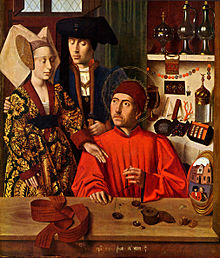
Back Eloi de Noyon AN اليجيوس ARZ Святы Элігій Byelorussian Eloi de Noyon Catalan Svatý Eligius Czech Eligius von Noyon German Eligio de Noyon Esperanto Eligio Spanish Eligius Estonian Eloi Basque
Eligius | |||||
|---|---|---|---|---|---|
 | |||||
| Confessor, Bishop | |||||
| Born | 11 June 588 Chaptelat, Francia | ||||
| Died | 1 December 660 Noyon, Neustria, Francia | ||||
| Venerated in | |||||
| Canonized | Pre-Congregation | ||||
| Feast | 1 December | ||||
| Attributes | Anvil; Bishop with a crosier in his right hand, on the open palm of his left a miniature church of chased gold; bishop with a hammer, anvil, and horseshoe; bishop with a horse; courtier; goldsmith; hammer; holding a horse's leg, which he detached from the horse in order to shoe it more easily; horseshoe; man grasping a devil's nose with pincers; man holding a chalice and goldsmith's hammer; man shoeing a horse; man with hammer and crown near a smithy; man with hammer, anvil, and Anthony the Great; pincers; with Godeberta; giving a ring to Godeberta; working as a goldsmith | ||||
| Patronage | Cartwrights; clockmakers; coin collectors; craftsmen of all kinds; cutlers; exercise riders and grooms; gilders; goldsmiths; harness makers; horses; jewelers; jockeys; knife makers; laborers; locksmiths; metalworkers in general; miners; minters; Royal Electrical and Mechanical Engineers; Royal Australian Electrical and Mechanical Engineers; saddlers; toolmakers; veterinarians; watchmakers | ||||
| |||||
Eligius[b] (French: Éloi; 11 June 588 – 1 December 660), venerated as Saint Eligius, was a Frankish goldsmith, courtier, and bishop who was chief counsellor to Dagobert I and later Bishop of Noyon–Tournai. His deeds were recorded in Vita Sancti Eligii, written by his friend Audoin of Rouen.
Born into a Gallo-Roman family, Eligius found success as a goldsmith at the Merovingian royal court of Clotaire II and served as chief counsellor to Dagobert I until Dagobert's death in 639. Under the subsequent regency of Nanthild, the queen consort, Eligius was ordained a priest and campaigned against simony in the Church. Appointed Bishop of Noyon–Tournai in 642, he founded many monasteries and churches while working to convert the pagan population of Flanders to Christianity.
Despite his background as a goldsmith, Eligius became increasingly ascetic during his time at the royal court and used his influence to ransom captive slaves and care for the poor. A legend emerged of him once healing a demon-possessed horse by amputating and miraculously re-attaching the horse's foreleg.
Eligius is best known for being the patron saint of horses and those who work with them. He is also the patron saint of goldsmiths, metalworkers, coin collectors, veterinarians, and the Royal Electrical and Mechanical Engineers (REME), a corps of the British Army.
- ^ van der Velden, Hugo (1998). "Defrocking St Eloi: Petrus Christus' vocational portrait of a goldsmith". Simiolus: Netherlands Quarterly for the History of Art. 26 (4): 243–276.
Cite error: There are <ref group=lower-alpha> tags or {{efn}} templates on this page, but the references will not show without a {{reflist|group=lower-alpha}} template or {{notelist}} template (see the help page).
© MMXXIII Rich X Search. We shall prevail. All rights reserved. Rich X Search
